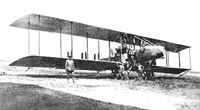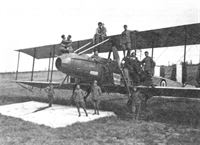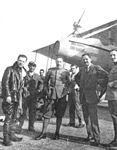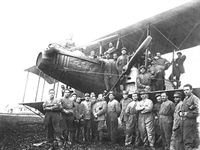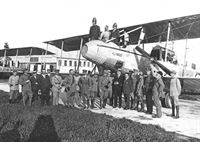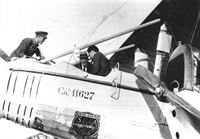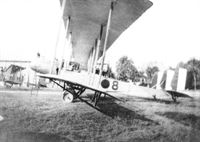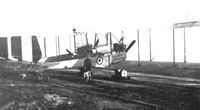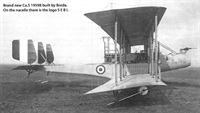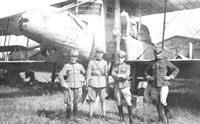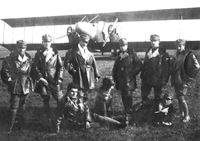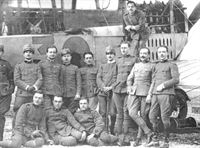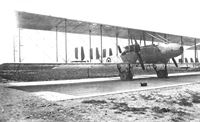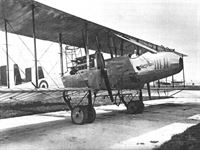
Описание
Страна: Италия
Год: 1917
Бомбардировщик
Варианты
- Caproni - Ca.1 - Ca.3 (Ca.30 - Ca.36) - 1914 - Италия
- Caproni - Ca.5 (Ca.44 - Ca.47) - 1917 - Италия
- В.Кондратьев Самолеты первой мировой войны
- А.Шепс Самолеты Первой мировой войны. Страны Антанты
- R.Abate,G.Alegi,G.Apostolo Aeroplani Caproni: Gianni Caproni and His Aircraft, 1910-1983
- J.Davilla Italian Aviation in the First World War. Vol.2: Aircraft A-H (A Centennial Perspective on Great War Airplanes 74)
- J.Davilla, A.Soltan French Aircraft of the First World War (Flying Machines)
- G.Swanborough, P.Bowers United States Military Aircraft Since 1909 (Putnam)
- G.Swanborough, P.Bowers United States Navy Aircraft Since 1911 (Putnam)
- Журнал Flight
-
R.Gentilli - Italian Aviation Units in the First World War. Vol.1 /Aeronaut/ (1)
Caproni Ca.5, 6a Squadriglia, October 1918
-
J.Davilla - Italian Aviation in the First World War. Vol.2: Aircraft A-H /Centennial Perspective/ (74)
Caproni Ca.5, 6a Squadriglia, Autumn 1918
-
R.Gentilli - Italian Aviation Units in the First World War. Vol.4 /Aeronaut/ (4)
Caproni Ca.5 #11610, 1a Squadriglia Navale S.A., Spring 1918
-
В.Кондратьев - Самолеты первой мировой войны
Caproni Ca-5, ВВС Италии, 1918г.
-
А.Шепс - Самолеты Первой мировой войны. Страны Антанты
Тяжелый бомбардировщик Капрони Ca-5 (1918г.)
-
R.Gentilli - Italian Aviation Units in the First World War. Vol.5 /Aeronaut/ (5)
Caproni Ca.5 #11587, US Navy, 1918
-
В.Кондратьев - Самолеты первой мировой войны
"Капрони" Са.5 над Венецией.
-
R.Gentilli - Italian Aviation Units in the First World War. Vol.4 /Aeronaut/ (4)
A Caproni Ca.5 of the 1a Squadriglia Navale in flight for a photo opportunity over Venice.
-
R.Gentilli - Italian Aviation Units in the First World War. Vol.4 /Aeronaut/ (4)
A camouflaged Ca.5 of the 203“ Squadriglia at Poggio Renatico.
-
R.Abate, G.Alegi, G.Apostolo - Aeroplani Caproni: Gianni Caproni and His Aircraft, 1910-1983
Having exhausted the original trimotor’s potential with the Ca.450, during the 1916-17 winter Caproni studied a more powerful derivative. The aircraft which emerged, called Ca.5 by the Italian Army, shared its predecessor’s general layout but differed in every detail. Wing span and chord were increased; the radiators were placed in the nose and tail booms; the nose wheel suppressed. The basic type, indicated as Ca.44 in the postwar system, was powered by three 200 hp Fiat A.12 engines, large quantities of which had been made available by the cancelling of orders for obsolete SP and SIA 14B biplanes.
-
J.Davilla - Italian Aviation in the First World War. Vol.2: Aircraft A-H /Centennial Perspective/ (74)
Caproni Ca.5 on a barge for maritime operations.
-
R.Gentilli - Italian Aviation Units in the First World War. Vol.5 /Aeronaut/ (5)
Ca.5 12258 at Ghedi, late 1918 - early 1919.
-
R.Gentilli - Italian Aviation Units in the First World War. Vol.1 /Aeronaut/ (1)
Ca.5 11553 of the 14a Squadriglia.
-
R.Gentilli - Italian Aviation Units in the First World War. Vol.4 /Aeronaut/ (4)
Caproni Ca.5 11585 of the 203a Squadriglia at Poggio Renatico.
-
R.Gentilli - Italian Aviation Units in the First World War. Vol.1 /Aeronaut/ (1)
Ca.5 11585 on 17 June, after landing at Villaverla, British personnel greet the Italian crew, and on the ground there are the bombs that fell on the airfield. The British, northern Italy being considered part of the Near East, are wearing pith helmets. (Archive Caliaro)
-
R.Abate, G.Alegi, G.Apostolo - Aeroplani Caproni: Gianni Caproni and His Aircraft, 1910-1983
The Ca.5 was also flown with 250 hp Isotta Fraschini V.6 engines, obtaining the version later identified as Ca.45. This group photo, in which Gianni Caproni is the sixth from the left, is taken in front of an aircraft built at Vizzola Ticino. The bomber appears to be painted green overall and has unusual underwing roundels.
-
H.Cowin - Aviation Pioneers /Osprey/
While the four man, biplane Caproni Ca 46 may have been the last of the company's illustrious line of World War I bombers, it was also the machine to be built in the greatest numbers by far, with 255 built in Italy by the parent company and sub-contractors, and more had been built in France by REP, plus five of the 1,000 ordered from Standard of the 400hp Liberty-engined version for use by American forces. Developed from the Ca 44 of early 1917, the Ca 46 was powered by three 300hp Fiat A 12s, giving it a top level speed of 95mph at 6.560 feet. Capable of carrying a bomb load of 1,300lb over a range of 760 miles, the machine had an operational ceiling of 15.000 feet.
-
R.Gentilli - Italian Aviation Units in the First World War. Vol.4 /Aeronaut/ (4)
Caproni Ca.5 11648 of the 203a Squadriglia with personnel posing in weird arrangements. (Trovato Finardi via Bussi)
-
R.Gentilli - Italian Aviation Units in the First World War. Vol.1 /Aeronaut/ (1)
The special crew that flew the first combat mission of a Caproni Ca.5 11585: at the center t.col. Armani, first on the left cap. Palotta, and last ten. Ridolfi.
-
R.Gentilli - Italian Aviation Units in the First World War. Vol.1 /Aeronaut/ (1)
Ca.5 11624 was assigned to the 14a Squadriglia, but did not fly on operations. (Archive Longhi - Mario Chirico)
-
R.Gentilli - Italian Aviation Units in the First World War. Vol.4 /Aeronaut/ (4)
Caproni Ca.5 11627 was the special machine for Gabriele d'Annunzio, carrying his personal insignia, "Semper adamas". Here it is at the Caproni factory with one of the many visiting groups.
-
R.Gentilli - Italian Aviation Units in the First World War. Vol.4 /Aeronaut/ (4)
A closer look of d'Annunzio's insignia, "Semper adamas", always steel. Under the cockpit there is a scroll with the name "Giuseppe Miraglia". The gentleman in the cockpit with Gianni Caproni is Arthur Duckham, chief of the Advisory Committee of the British Ministry of Ammunitions.
-
R.Gentilli - Italian Aviation Units in the First World War. Vol.1 /Aeronaut/ (1)
The new Caproni Ca.5 600 hp at Tombetta airfield, Verona, in October 1918. (Archive Caliaro)
-
J.Davilla - Italian Aviation in the First World War. Vol.2: Aircraft A-H /Centennial Perspective/ (74)
Caproni Ca.5 #12222 (on the other side it was mistakenly written as 1222) in which Liberty engines have been installed as a prototype for its production in Italy. Also, American production was considered.
-
R.Gentilli - Italian Aviation Units in the First World War. Vol.5 /Aeronaut/ (5)
Caproni Ca.5 11587 US Navy, summer 1918.
-
R.Gentilli - Italian Aviation Units in the First World War. Vol.1 /Aeronaut/ (1)
A Caproni Ca.5 of the 6a Squadriglia.
-
R.Gentilli - Italian Aviation Units in the First World War. Vol.4 /Aeronaut/ (4)
A Caproni Ca.5 at Brindisi, with the American roundel on the rudder.
-
J.Davilla, A.Soltan - French Aircraft of the First World War /Flying Machines/
Caproni 3 (serial CAP 502) with elevated gunner's mount and Eteve stand. At least three Caproni 3s were built by R.E.P.
-
R.Gentilli - Italian Aviation Units in the First World War. Vol.5 /Aeronaut/ (5)
Brand new Ca.5 19598 built by Breda. On the nacelle there is the logo S E B I.
-
R.Gentilli - Italian Aviation Units in the First World War. Vol.5 /Aeronaut/ (5)
Ca.5 Berlina 12036 of the Prima Squadra del Levante, first squad of the East, with the name Caproni written in Arabic characters and on its nose the Roman eagle, insignia of the Gruppo Comunicazioni Aeree. (Archive Mario Federighi)
-
Журнал - Flight за 1919 г.
THE ITALIAN REPRESENTATIVES AT THE E.L.T.A.: 3. The Caproni three-engined biplane
-
R.Gentilli - Italian Aviation Units in the First World War. Vol.4 /Aeronaut/ (4)
A Caproni Ca.5 and an SVA at Brindisi. The Caproni shows an American roundel, possibly being one of the Ca.5s that American pilots flew to Apulia in July 1918 for missions across the Adriatic that were not flown for technical problems of the airplane.
Другие самолёты на фотографии: Ansaldo SVA.2/3/4/5 - Италия - 1917
-
J.Davilla, A.Soltan - French Aircraft of the First World War /Flying Machines/
Caproni 3 (Caproni 45). SHAA records indicate that 20 were obtained directly from Italy.
-
J.Davilla, A.Soltan - French Aircraft of the First World War /Flying Machines/
Caproni 3. These aircraft were powered by three 200-hp Fiat A12 engines.
-
J.Davilla - Italian Aviation in the First World War. Vol.2: Aircraft A-H /Centennial Perspective/ (74)
A US Navy Caproni Ca-44 serving with the Northern Bombing Group Night Wing at Orly.
Caproni Ca.5 with USN serial B-15 photographed at the US Army airfield at Orly, France, for evaluation. Armament has not been installed but American markings have been applied. -
J.Davilla - Italian Aviation in the First World War. Vol.2: Aircraft A-H /Centennial Perspective/ (74)
Caproni Ca.5 42118 at Hazelhurst Field, US, in September 1918.
-
R.Abate, G.Alegi, G.Apostolo - Aeroplani Caproni: Gianni Caproni and His Aircraft, 1910-1983
Ca.5 SC 42119 is one of three Liberty powered aircraft delivered by Fisher Body to the United States Signal Corps in 1918. The rampant ram and excellent finish are clearly evident.
-
R.Abate, G.Alegi, G.Apostolo - Aeroplani Caproni: Gianni Caproni and His Aircraft, 1910-1983
The Ca.5’s internal radiators were beset with cooling problems. Although the new position cut drag somewhat, cooling was also reduced. One the various modifications attempted to correct the problem is seen on this American aircraft at Mineola: the fuselage lines are noticeably altered.
-
R.Abate, G.Alegi, G.Apostolo - Aeroplani Caproni: Gianni Caproni and His Aircraft, 1910-1983
Another view of the Liberty-equipped Ca.5 with its boxy nacelle, side mounted radiators and clear observation panels on the nose.
-
J.Davilla - Italian Aviation in the First World War. Vol.2: Aircraft A-H /Centennial Perspective/ (74)
Caproni Ca.5 42118 at Hazelhurst Field, US, in September 1918.
-
R.Gentilli - Italian Aviation Units in the First World War. Vol.3 /Aeronaut/ (3)
Giorgio Pessi, a.k.a. Giuliano Parvis, in the United States, in front of a Standard-built Caproni 600 hp at Hazelhurst Field.
-
J.Davilla - Italian Aviation in the First World War. Vol.2: Aircraft A-H /Centennial Perspective/ (74)
An American officer, easily recognized by the headgear, stands in front of Ca.5 12222. The Liberty engine's greater size is clearly evident.
-
R.Gentilli - Italian Aviation Units in the First World War. Vol.4 /Aeronaut/ (4)
A late-production Ca.5 of the 204a Squadriglia, with Isotta Fraschini engines, at Brindisi. (Archive Mauro Antonellini)
-
Jane's All The World Aircraft 1919 /Jane's/
Italian Aviators and Civilian Aviators with an Italian Service machine.
-
R.Abate, G.Alegi, G.Apostolo - Aeroplani Caproni: Gianni Caproni and His Aircraft, 1910-1983
The American pilots James Bahl, at left, and DeWitt Coleman, at right, standing by their Ca.5. Shot down during an operational sortie they were awarded respectively a medaglia d'oro and a medaglia d'argento.
-
R.Abate, G.Alegi, G.Apostolo - Aeroplani Caproni: Gianni Caproni and His Aircraft, 1910-1983
LaGuardia at Taliedo, taking delivery of a Ca.5 for the US Army. A strong opponent of the SIA 7, whose dangerous unreliability the Americans had experienced first hand, LaGuardia became instead an ardent supporter of the Caproni bombers.
-
R.Gentilli - Italian Aviation Units in the First World War. Vol.1 /Aeronaut/ (1)
The airmen of the 6a Squadriglia with a Caproni Ca.5.
-
R.Gentilli - Italian Aviation Units in the First World War. Vol.4 /Aeronaut/ (4)
Caproni Ca.5 11609 ready for delivery to the 1a Squadriglia Navale SA, showing the shackles for the torpedo.
-
R.Gentilli - Italian Aviation Units in the First World War. Vol.4 /Aeronaut/ (4)
Ca.5 11610; the insignia of the 1a Squadriglia Navale was applied directly at the factory.
Some Ca.5 were also completed as torpedo bombers. Ca.11610, here pictured on Taliedo’s concrete runway, carries the insignia of the Prima Squadriglia Siluranti Aeree (First Airborne Torpedo Squadron) “San Marco”, formed under D’Annunzio’s command at Venice’s San Nicolo airfield in March 1918. -
J.Herris - Weird Wings of WWI /Centennial Perspective/ (70)
The Caproni biplane was widely used and was fairly successful. Its twin-boom configuration enabled fitting of three engines, a tractor at the front of each boom and a pusher in the central nacelle. Normally fitted with wheels, a few were used as floatplanes as shown here.
-
R.Abate, G.Alegi, G.Apostolo - Aeroplani Caproni: Gianni Caproni and His Aircraft, 1910-1983
From the basic Ca.5 design maggiore Alessandro Guidoni derived the Idrovolante Caproni (I.Ca., retroactively known as Ca.47 postwar) by replacing the undercarriage with two Zari floats, connected to the fuselage with elastic mounts. The first machine was sent to Venice for testing August 1917 but was unfortunately destroyed by an incendiary bomb before any tests were carried out. A second machine, readied and proposed to the Navy as torpedo bomber, was also lost during a ferry flight between Sesto Calende and La Spezia.
-
R.Abate, G.Alegi, G.Apostolo - Aeroplani Caproni: Gianni Caproni and His Aircraft, 1910-1983
The second I.Ca taxying at Sesto Calende. After the war Piaggio completed ten by converting a batch of Ca.5 landplanes.
-
R.Abate, G.Alegi, G.Apostolo - Aeroplani Caproni: Gianni Caproni and His Aircraft, 1910-1983
Caproni’s first attempt at producing an aircraft that would carry badly wounded soldiers to properly equipped hospitals dates to the First World War, when a Ca.5 biplane bomber was modified by installing two stretchers on the top of its twin tail booms. To provide a measure of protection from weather and propwash, the stretchers were partially faired. Also known as Ca.45, the aircraft could also carry two lightly wounded men in the main nacelle.
-
R.Gentilli - Italian Aviation Units in the First World War. Vol.5 /Aeronaut/ (5)
Some of the airplanes of the 350a Squadriglia at El Palomar airfield, Argentina: two Aviatiks, a Fiat R.2, two Farmans, a Caproni Ca.5.
Другие самолёты на фотографии: Aviatik B.I / B.II / P.15 - Германия - 1913FIAT R2 - Италия - 1918Maurice Farman MF.11 Shorthorn - Франция - 1913
-
J.Davilla - Italian Aviation in the First World War. Vol.2: Aircraft A-H /Centennial Perspective/ (74)
One FIAT R.2, two Aviatiks, two Farmans, and one Caproni, at El Palomar, Argentina.
Другие самолёты на фотографии: Aviatik B.I / B.II / P.15 - Германия - 1913FIAT R2 - Италия - 1918Maurice Farman MF.11 Shorthorn - Франция - 1913
-
R.Abate, G.Alegi, G.Apostolo - Aeroplani Caproni: Gianni Caproni and His Aircraft, 1910-1983
In the early part of the war aircraft had been ordered piecemeal in small batches. The policy changed when the Republican member of Parliament Eugenio Chiesa was appointed commissioner of aeronautics. Among the types selected for mass production was the Ca.5, a dedicated Caproni Aircraft Production Office being established in Milan. The office, run first by capitano Oscar Sinigaglia and later by capitano Odiemo, placed orders for 4,015 aircraft with eight Italian companies. Output was negatively affected by the difficulty of introducing aircraft manufacturing techniques in non-aviation firms. Thus in 1918, while Caproni completed 359 bombers, the performance of other program participants was negligible. The photo show Ca.5 production.
-
R.Abate, G.Alegi, G.Apostolo - Aeroplani Caproni: Gianni Caproni and His Aircraft, 1910-1983
The Americans took an active interest in the Ca.5, ordering 1,050 aircraft from Standard Aircraft, Curtiss and Fisher Body. Equipped with three 450 hp Liberty engines, this version was referred to postwar as Ca.46. A comparison with the Handley-Page O/400, also selected for production in the United States, showed the Caproni to be 15 kilometers per hour faster, to climb almost twice as fast, to have one-third more range, and to cost 29,850 dollars instead of 57,900. The Handley-Page could carry a 900 kg payload - 300 more than the Caproni. On the photo, Standard Aircraft’s assembly hall in Elizabeth, New Jersey.
-
R.Gentilli - Italian Aviation Units in the First World War. Vol.5 /Aeronaut/ (5)
Ca.5 of the US Navy assigned to the Northern Bomber Group in France.
-
В.Кондратьев - Самолеты первой мировой войны
"Капрони" Са.5
В.Кондратьев Самолеты первой мировой войны
КАПРОНИ Ca.5 / CAPRONI Ca.5
Одновременно с работами над Ca.4 Джанни Капрони продолжал совершенствовать свои предыдущие самолеты бипланной схемы. Итогом этих работ стал тип Ca.5 - несколько увеличенный в размерах Ca.3 с улучшенной аэродинамикой и более мощными двигателями. Летные данные машины заметно повысились, и в 1917 году Ca.5 приняли на вооружение.
До конца войны "пятерки" постепенно заменили во фронтовых эскадрильях самолеты более ранних модификаций. Под общим армейским индексом Ca.5 строилось несколько версий машины: Ca.44, Ca.45, Ca.46 и Ca.47 с незначительными конструктивными различиями. В Италии было выпущено 255 экземпляров Ca.5. Кроме того, самолет строили по лицензии в США и во Франции.
ДВИГАТЕЛИ
3 "Фиата" по 300 л.с.
ВООРУЖЕНИЕ
Кольцевая турель с одним или двумя пулеметами "Ревелли" в носовой части гондолы и вторая такая же турель на специальном помосте над задним двигателем.
Ca.5 поднимал 530 кг бомб.
ЛЕТНО-ТЕХНИЧЕСКИЕ ХАРАКТЕРИСТИКИ
Ca-5, 1917г.
Размах, м 23,0
Длина, м 12,40
Высота, м 4,47
Площадь крыла, кв.м 150,0
Сухой вес, кг 3005
Взлетный вес, кг 5312
Двигатель: "Фиат"
число х мощность, л. с. 3x300
Скорость максимальная, км/ч 152
Дальность полета, км 450
Продолжительность полета, час, мин 4,0
Потолок, м 4500
Экипаж, чел. 3-4
Вооружение 2-4 пулемета
533 кг бомб
Описание:














